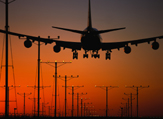Charter Flights are Gaining in Popularity with Small Ski Groups
By Dick Healy
The hassle of getting
ski/snowboard equipment and boots onto commercial airlines, lugging the
baggage through a busy airplane terminal and facing the same ordeal at the
end of a long day on the slopes, can be daunting. And if you talk to a
skier whose equipment was delayed or lost by commercial airlines, frustration can border on rage.
was delayed or lost by commercial airlines, frustration can border on rage.
Long distance ski travel by
plane can be even more perplexing if you have to make a connecting flight in
route to your resort destination, and miss it. That’s why today’s savvy
travelers are opting to take charter group flights to their favorite ski
resort. The flexibility charter flights offer also eliminates the long hours
of pre-flight booking required by commercial carriers.
A jet charter that can carry
anywhere from four to nine trekkers can be booked and ready to go on short
notice. Many chartered aircraft operate from a variety of major and smaller
airports throughout the country, thus making boarding and unloading easier
and faster. Though even when operating out of major airports, air charter
planes offer a much quicker and easier means of travel.
“ Oh, but private jets are
too expensive,” some will say. “ Charter jet service is only for corporate
types with large expense accounts, and Hollywood stars.” Perhaps air charter
once was the preferred travel of the elite few, but no longer.
Let’s do the math. Say six
friends decide to take a ski trip to Aspen, Colorado or Deer Valley, Utah.
Aside from the pleasure of traveling in the comfort of a private jet, the
costs are well justified compared to commercial flights in many ways.
Valuable downtime is avoided, you get to the slopes quicker, the overall
flight charge is split six ways and a jet generally with two pilots, can
make last minute flight changes if necessary. An option most commercial
flight can’t entertain when they have dozens of other passengers on board.
Charter jet rates range on
average from $2,300 to $2,800 an hour, depending on the size of the
aircraft. Today’s charter operations are very sophisticated. They can
arrange bedside to bedside services. Charter companies can provide limo
transportation to and from an airport, and provide catering service if
needed. In the case of Quik Flight, which operates out of the
Million-Air building at Albany, New York International Airport, air
ambulance service is also available.
According to Quik Flight
President, Chandler Atkins, “ We provide medically equipped aircraft along
with caring professional medical personnel, including a doctor on board when
required as well as support equipment and medications.”
Atkins uses Quik Flight’s
twin-engine Cheyenne turbo-prop for either private and air ambulance when
transporting clients 500 nautical miles or less one way. He says this is
very cost competitive. For example, a round trip flight from Albany to
Washington, DC is approximately $2,619 on the Cheyenne.
At last count there were
some 29,000 private jets flying around the country, with many more on order.
Though chartering jets is preferred by many flyers, Netjets, owned by Warren
Buffet, offer fractional ownership. Flexjet, a Bombardier entity, offers
similar fractional investment.
One entrepreneur I know buys
blocks of time, meaning he puts up $150,000 so he can order in a jet to
service his family or business flight needs on demand. Other owners buy a
jet outright and lease it when not being utilized for personal use. Quik
Flight, as well as other charter companies, are set up to manage such craft
and can handle every detail from supplying pilots, bookings flights,
purchasing fuel and providing hanger space.
The old cliché that the “
World is Shrinking” was never so apt as in the world of charter and
fractional shares. If you want to ski in Europe, there are a growing number
of private transatlantic jets available. Though the price tag, owing to the
size of a jet aircraft required, and the great non-stop distance, is
considerably higher.
Though I have primarily put
the emphasis on chartered jets, some carries utilize the very reliable
Pilatus PC-12, manufactured in Switzerland since 1935. Powered by a single
Pratt & Whitney Canada PT6A-67B engine, the turboprop airplane has a maximum
range of 1,469 nautical miles. In ski country where runways are often
limited in length, the Pilatus can use runways as small as 2,5000 feet.
Furthermore, the Pilatus can carry eight or nine skiers, with plenty of
storage space left for ski gear and clothing. Pilatus airplanes can also
operate for one-third that of a jet, yet still cruise at a respectable
310-mph.
Personal air travel is here
to stay. Get aboard on your next ski trek.
Sidebar: Quik
Flight offers free charter quotes on both turboprop aircraft and jets to any destination. They can be
reached at: 518-869-8000.